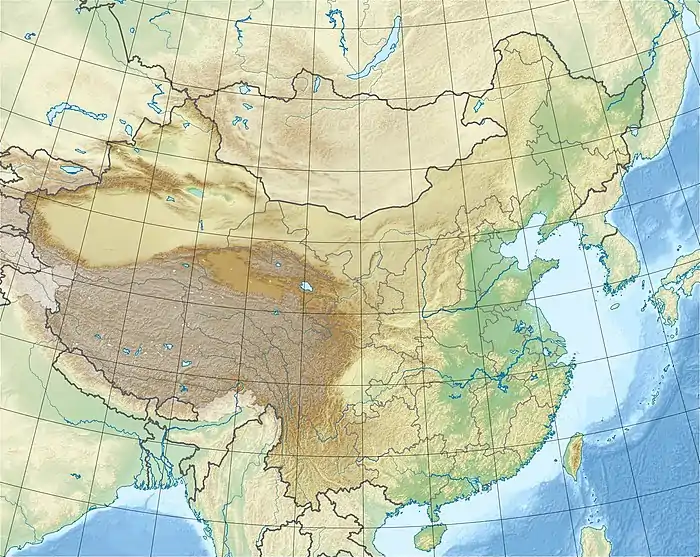| Guanling Formation | |
|---|---|
| Stratigraphic range: early-mid Anisian (Pelsonian) ~ | |
| Type | Geological formation |
| Underlies | Yangliujing Formation |
| Overlies | Jialingjiang Formation |
| Lithology | |
| Primary | Mudstone, limestone |
| Other | Dolomite |
| Location | |
| Coordinates | 25°30′N 104°54′E / 25.5°N 104.9°E |
| Approximate paleocoordinates | 11°42′N 94°12′E / 11.7°N 94.2°E |
| Region | Guizhou & Yunnan Provinces |
| Country | |
| Extent | Yunnan–Guizhou Plateau |
 Guanling Formation (China)  Guanling Formation (Guizhou) | |
The Guanling Formation is a Middle Triassic (Anisian or Pelsonian in the regional chronostratigraphy) geologic formation in southwestern China.
Geology
The formation encompasses two members. The first member is primarily calcareous mudstone and dolomite, indicative of a coastal environment. The second member is a thicker marine sequence of dark micritic limestone with some dolomite. Two distinct fossil assemblages are found in the second member. The older Luoping biota preserves abundant arthropods along with fossils from other invertebrates and vertebrates, which are rare but well-preserved. The slightly younger Panxian fauna has a more diverse and common assortment of marine reptiles such as sauropterygians.[1]
A tuff bed in the Luoping biota has been dated to 244.5 ± 2.2 Ma via U-Pb SHRIMP dating. The Luoping biota as a whole was deposited over a period of 340 ± 71 kyr. This estimate is justified by cyclostratigraphic evidence, as indicated by fluctuations of terrestrial proxy metals.[2]
Fossil content
Among others, the following fossils were reported from the formation:
- Atopodentatus
- Austronaga[3]
- Barracudasauroides
- Diandongosaurus
- Dianopachysaurus
- Dinocephalosaurus[4]
- Gracilicollum
- Honghesaurus
- Kyphosichthys
- Largocephalosaurus
- Luopingosaurus[5]
- Luoxiongichthys
- Luxisaurus[4]
- Mixosaurus
- Pectodens[4]
- Qianosuchus
- Sanchiaosaurus
- Sinosaurichthys
- Sinosaurosphargis
- Wumengosaurus
- Xinminosaurus
References
- ↑ Benton, Michael J.; Zhang, Qiyue; Hu, Shixue; Chen, Zhong-Qiang; Wen, Wen; Liu, Jun; Huang, Jinyuan; Zhou, Changyong; Xie, Tao; Tong, Jinnan; Choo, Brian (2013-10-01). "Exceptional vertebrate biotas from the Triassic of China, and the expansion of marine ecosystems after the Permo-Triassic mass extinction". Earth-Science Reviews. 125: 199–243. doi:10.1016/j.earscirev.2013.05.014. ISSN 0012-8252.
- ↑ Ma, Zhixin; Wu, Huaichun; Hu, Shixue; Fang, Qiang; Liu, Xiting; Zhou, Changyong; Wen, Wen; Zhang, Qiyue; Huang, Jinyuan; Min, Xiao (2023-09-26). "Temporal duration and preservation mechanism of the Middle Triassic Luoping biota from South China constrained by geochronology and cyclostratigraphy". Global and Planetary Change: 104254. doi:10.1016/j.gloplacha.2023.104254. ISSN 0921-8181.
- ↑ Wang, W.; Lei, H.; Li, C. (2023). "A small-sized dinocephalosaurid archosauromorph from the Middle Triassic of Yunnan, southwestern China". Vertebrata PalAsiatica. doi:10.19615/j.cnki.2096-9899.231013.
- 1 2 3 Lu, Yu-Ting; Liu, Jun (2023-10-02). "A new tanystropheid (Diapsida: Archosauromorpha) from the Middle Triassic of SW China and the biogeographical origin of Tanystropheidae". Journal of Systematic Palaeontology. 21 (1). doi:10.1080/14772019.2023.2250778. ISSN 1477-2019.
- ↑ Xu, G.-H.; Shang, Q.-H.; Wang, W.; Ren, Y.; Lei, H.; Liao, J.-L.; Zhao, L.-J.; Li, C. (2023). "A new long-snouted marine reptile from the Middle Triassic of China illuminates pachypleurosauroid evolution". Scientific Reports. 13 (1). 16. doi:10.1038/s41598-022-24930-y. ISSN 2045-2322. PMC 9816097.